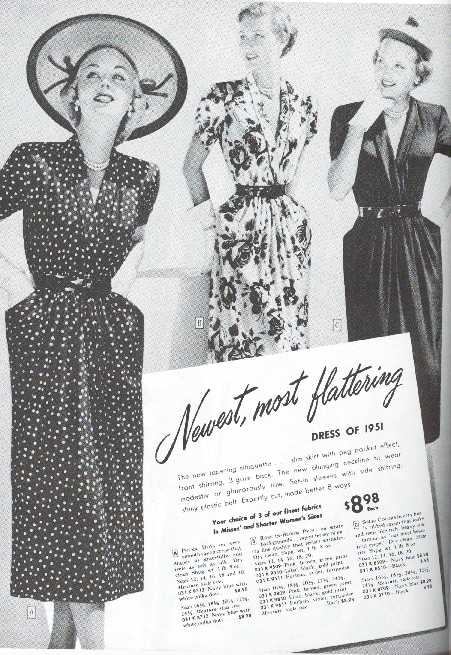| |
|
The "New Look"
Dior's 1947
Collection Begins the Revolution |
 |
|
|
The war was over, the boys were home, the restrictions were lifted,
and the economy was reviving.
It was
time. |
| |
| In February 1947,
Christian Dior introduced the first major postwar collection, called the
"Carolle Line" (16), but soon dubbed the "New
Look" by American journalists in Life Magazine. Dior, along with every
moderately fashion-conscious female of the times, was long wearied of the
harsh Utility style clothes and their masculine quality. With his lavishly
soft, purposefully elegant line, Dior did away with wartime fashions and
began the flood of radical changes that were to follow. In a single
movement he created one of the most distinct looks of the century.
|
|
| What was the "New Look?" |
| The "New Look" is most
recognizable by its curvy shape and line, a far cry from its immediate
predecessors. The desired look was a womanly hourglass figure, with a tiny
waist, full hips, and a plentiful bust. Shoulders were no longer squared,
but rounded and natural. Jackets were pinched in at the waist, and dresses
had darts to accommodate the fabric increase from small waist to large
chest and hips. Skirts were mid calf and full, flowing with layers of
nylon petticoats. The freedom and grandeur of the skirts gave both a
glamorous feeling and appearance. Variations on skirt line and length
emerged as the decade progressed, and encompassed a great variety of
styles. Women were adorned with hats, gloves, shoes, and purses; all the
accessories to match. |
|
| One of his more famous designs in the New Look
line was "The Bar," pictured below (16) |

|
|
The idea was to be an image, have a presence, and
simply glow with feminine elegance and beauty. |
|
| What made it so appealing? |
| Aesthetic sensibilities
inevitably must take a backseat in times of crisis. So of course women
found the wartime styles oppressive, restricting both their stylistic
tastes and feminine inclinations. |
The New Look quickly became an iconographic symbol of youth
and beauty, as well as a herald for a hopeful and promising
future. |
| |
| Without the constant
economical oppressions of war, the American public was learning the
beautiful art of spending money on themselves. The overtones of frivolity
in Dior's and many others' styles became socially accepted, even if not
publicly acknowledged. Dior himself was quoted in saying, "Novelty is the
very essence of the fashion trade." (1, p. 40)
|
| |
| The Trickle-Down
Effect |
| Obviously, not every
woman of the fifties could glide around in a brand-new formal Dior ball
gown. This was particularly true in America, where the haute couture
styles found on the streets of Paris had never been physically tangible.
Despite the obvious price barriers, (Dior's gowns ranged from $300-$2400),
they were clearly of little practical use in everyday life. For evening
and formal affairs, a Dior would be totally acceptable; as would a
comparable copy. |
| |
| Dior's designs were a
conception, a model, an ideal to be strived for and sought after. He must
be given credit for the vision of feminine grace and elegance that the
majority of fifties styles came to strive for. |
| |
| But what about the
average American housewife? Sears Catalogues from the era are an authentic
indication of everyday style. The trickle-down effect of Dior's New Look
style is distinct and marked all the way through the end of the decade.
The most common adaptation was the shirtwaist dress, which showed the
desired hourglass shape, but was more practical than formalwear.
|

Advertisement for classic shirtwaist dress (9, p.
8) |
| |
|
|


